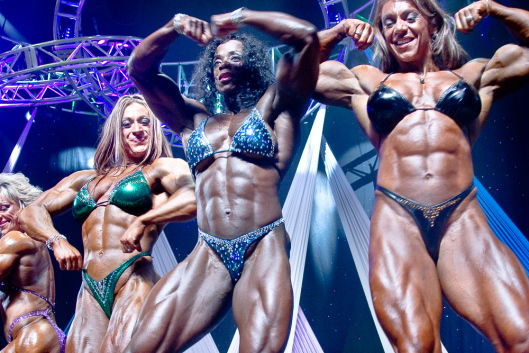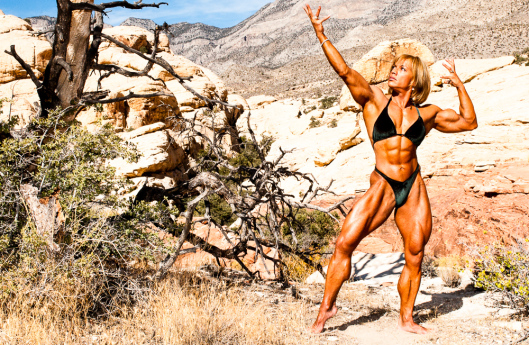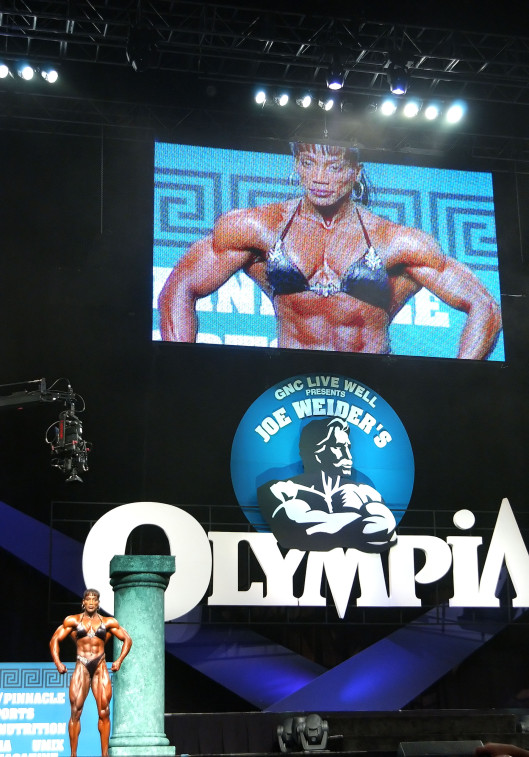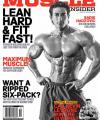Why Aesthetic Female Muscle Is Important

A NEW ARCHETYPE
When Pumping Iron author Charles Gaines first saw women bodybuilders in the late 1970s he declared they represented a “new archetype” – a kind of body never seen before in any culture anywhere in the world at any time in history. Women who develop their muscles for aesthetic purposes are “something new under the sun” and represent something radically new and highly significant to human culture.
The ancient Greeks celebrated the athletic male body with paintings and sculpture but the women in their art tended to be shown as soft and shapely, manifestations of Aphrodite, goddess of love and sexuality, whom the Romans called Venus. An artist like Michelangelo working centuries later also focused on powerful and muscular male figures while his women, although often possessing powerful bodies, are decidedly not muscular to anything like the same extent.
FEMALE MUSCLE AND FEMINISM
Today we live in an age that regularly celebrates “feminism” to one degree or another. The 19th Amendment gave US women the right to vote in 1920. Throughout the rest of the 20th century we saw women succeeding in business, the professions, sport and politics. Times have changed to such a degree that we are looking at the likelihood the next president will be a woman. This represents a tremendous culture change in a relatively short time.

Ms. Olympia 1980 – In the beginning was definition.
But when bodybuilding for women came into being a very few decades ago they found very few allies among the feminists. Women who nowadays seem no more muscular than a contemporary fitness model were demonized for being freakish and “looking like men.” There were periods of greater relative acceptance but recently the International Federation of Bodybuildings (IFBB) dropped women’s bodybuilding from the Olympia world professional championships and Arnold Schwarzenegger did the same thing at his Arnold’s Sports Festival.
A federation with the word “bodybuilders” in the tile continues to support competition for male bodybuilders and for women to compete in fitness, figure, physique and bikini – but no female bodybuilding. The Arnold Sports Festival has places for judo, dance, jump rope and pole dancing has no room for women’s bodybuilding, which was one of the founding competitions of the event.
In the past the IFBB has adopted “guidelines” that dictated women bodybuilders would not try as hard or achieve the same level of success as their male counterparts. Politics has created some enormously unfair outcomes in competitions. But at
no point during the history of female muscle competition has the National Organization for Women or others who advocate for equal treatment for women bothered to come to the support of these aesthetically muscular females. It is as if the culture is all for women maximizing their talents, abilities and potentials in all areas – except when it comes to the development of their bodies. Women judges, scientists, lawyers and even presidents, fine. Women with aesthetic and athletically developed muscles, that’s just going too far!

TWO ASPECTS OF FEMALE MUSCLE
Actually, there are two aspects of aesthetic female muscle that need to be considered. One is how long it took for women to discover this physical alternative available to them. The other is how easy it was to do once they made this discovery. Once female muscle contests were established in not very many years we saw women bodybuilders putting on impressive muscle mass and muscularity, followed by women with different genetics and goals filling up the ranks of fitness, figure, physique and fit bikini competitions.
Today there are tens of thousands of women competitors in various classes and categories all over the world – and at least hundreds of thousands of fans and supporters. Beginning with a few minimally developed women in 1977 and 1978 the idea of women developing their muscles for primarily aesthetic purposes has taken firm hold in modern culture.
So what does this tell us? For one thing, it demonstrates how natural it is for at least some women to develop muscle mass and hyper-muscularity. For those with the appropriate genetics, a few months to a few years working in a gym can result in a body capable of competing in one category of muscle contest or another. If this is true now it means it was always true. Some women throughout history have always been capable of building this kind of body. They simply weren’t encouraged or allowed to. Since most human in history have been peasant farmers it means that women have had to work in the fields alongside their men and have had to develop physical strength.

Lightweight female bodybuilders like Juliette Bergmann has all the qualities of champions – just in a smaller package.
ASSUMPTIONS AND STEREOTYPES
But women have never been included in the celebration of aesthetic physical development that began with the Greeks and continued on through the Renaissance and beyond. There have been many categories of achievement throughout time that were open to men and not to women, and developing an aesthetically muscular athletic physique is just one of them.
But one problem is that our world has formed its opinions about the nature and capabilities of women on the basis of such things as the roles they have been assigned to by human culture. Women have been considered too emotional and not intellectually gifted enough to assume roles we have traditionally reserved for men. Such as voting, for example. So recognizing that at least some women can develop beautiful and highly muscular bodies, that they are capable of remarkable athletic performance and feats of strength and can function in such roles as police officer, fight fighter or combat soldier has met with considerable opposition.

After bodybuilding came fitness, figure, physique and fit bikini.
Of course, not all women are endowed with either the genetics nor the psychology to develop big muscles and muscularity. But neither are all men. Gyms nowadays are full of women who are superior in terms of muscle and strength to many of the men on the gym floor. The biggest and strongest men will always be bigger and stronger than the biggest and strongest women. But the world nowadays is full of females who can do a 300 pound bench press and there aren’t many men capable of matching that feat.
The kind of women who compete at the upper levels of any muscle contest don’t need to be reminded of they capabilities. Nor do the top women athletes in the Olympics or other sports competition need anyone’s permission to focus on achieving their best possible performance. They are far past the point where what people in general, their detractors or the overall culture can say or do to dissuade or discourage them.
EDUCATING THE CULTURE
But there is still everyone else to convince. There are women without the highest level of motivation who need to be informed as to their own potentials and encouraged to strive to be their best. There are husbands, boyfriends and family members who should stop being part of the problem and become a factor in the solution. There are doctors, employers, lawmakers and others who need to be bought up to date so they allow and encourage women to pursue physical and athletic improvement without being told they are too “masculine.”
We have experienced a century or so of feminism that, at least in a large part of what we call the “first world,” has opened the gates of opportunity for women wide open. We are seeing a golden age of athletics for women, demonstrated by the fact that so many events for women in the Olympics are much more popular than the same events for men. We may know about Michael Phelps in swimming but the female gymnasts are going to end up with the lion’s share of commercial endorsements.

Nowadays women athletes in most sports improve their bodies with weight training.
But muscle competition is not about sports performance. It is muscular development for its own sake, judged on the basis of aesthetics – not performance. Male bodybuilders have always faced a certain about of criticism for being too narcissistic. But because bodybuilding-type weight training has become so wide spread that we see the same kind of muscular development in all sort of athletes in a variety of sports – and even in the bodies of male models, movie stars and rap artists. So hyper-muscularity for men has become pretty well established.
Not so with the women. Within the federations governing competition, there is not much opposition to women with muscle in the “beauty contest” categories like fitness or figure – although the judging standards have always fought a rear guard action to try and slow down the increasing muscular development of the competitors as much as possible. But because the female bodybuilders are frequently so much bigger this has kind of made the world safe for the smaller competitors who seem to much less extreme by comparison.

Women worried abut their hips, thighs and butts being out of shape should take a look at the bodies of muscle competitors.
TOWARD A NEW ERA OF CHOICE
But dropping women’s bodybuilding from the Olympia and the Arnold represents a total betrayal of the these competitors whom the IFBB is tasked with supporting and promoting as they do the other athlete members of the federation. This attitude toward the women represents a rejection of the idea that females should be able to develop any and all of their physical or mental abilities to whatever degree this is possible. Instead, it dictates that the culture has the authority and responsibility for maintaining whatever stereotype of femininity and the nature of the female body it cares to impose.
When we see women in some cultures being forced to cover up their bodies, not allowed to go to school or even to drive a car we rise up in protest. But the fact is the same kind of thing is also prevalent right here at home when women with the genetics to build large, symmetrical, proportionate and beautifully shaped muscle and to use diet to create extreme definition and muscularity are criticized and penalized for doing so.
It is time to add the choice to develop their muscles to the other freedoms for women our culture has come to celebrate over the years. Women have the right to decide to develop whatever of their abilities that are within their physical capabilities.

Lenda Murray, 8-time Ms. Olympia – a contest that the IFBB no longer allows.
ON THE OTHER HAND
While female bodybuilding is under attack in some quarters, it is good to keep in mind that not all federations and organizations have the same point of view. There are contest for female bodybuilding being held successfully all over the world. It is also important to realize that every time in modern history that women have attempted to break through boundaries and achieve in new areas they have encountered opposition. Over time this opposition has been overcome and women been able to move ahead toward their goals.
This will no doubt be the case over time with bodybuilding for women.
BILL DOBBINS PHOTOGRAPHY
www.billdobbins.com
www.billdobbinsphotography.com

